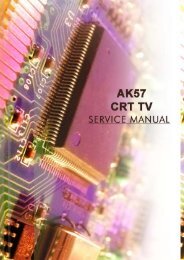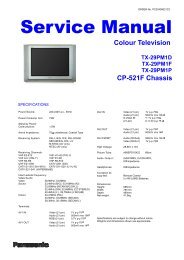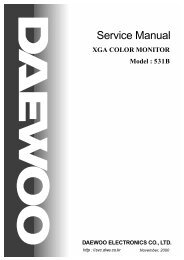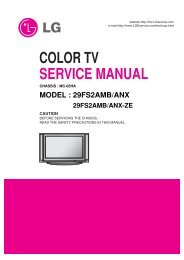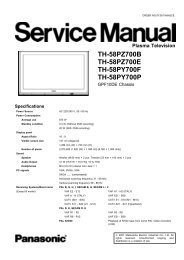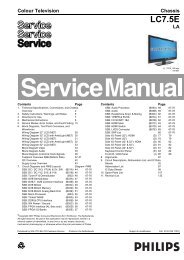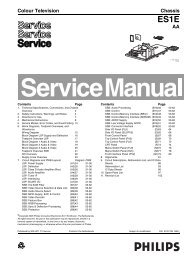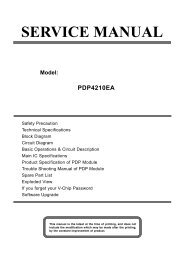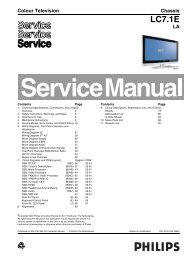You also want an ePaper? Increase the reach of your titles
YUMPU automatically turns print PDFs into web optimized ePapers that Google loves.
Safety Instructions, Warnings, and Notes <strong>LC7.1E</strong> PA 2. EN 5<br />
2. Safety Instructions, Warnings, and Notes<br />
Index of this chapter:<br />
2.1 Safety Instructions<br />
2.2 Warnings<br />
2.3 Notes<br />
2.1 Safety Instructions<br />
Safety regulations require the following during a repair:<br />
• Connect the set to the Mains/AC Power via an isolation<br />
transformer (> 800 VA).<br />
• Replace safety components, indicated by the symbol ,<br />
only by components identical to the original ones. Any<br />
other component substitution (other than original type) may<br />
increase risk of fire or electrical shock hazard.<br />
Safety regulations require that after a repair, the set must be<br />
returned in its original condition. Pay in particular attention to<br />
the following points:<br />
• Route the wire trees correctly and fix them with the<br />
mounted cable clamps.<br />
• Check the insulation of the Mains/AC Power lead for<br />
external damage.<br />
• Check the strain relief of the Mains/AC Power cord for<br />
proper function.<br />
• Check the electrical DC resistance between the Mains/AC<br />
Power plug and the secondary side (only for sets that have<br />
a Mains/AC Power isolated power supply):<br />
1. Unplug the Mains/AC Power cord and connect a wire<br />
between the two pins of the Mains/AC Power plug.<br />
2. Set the Mains/AC Power switch to the "on" position<br />
(keep the Mains/AC Power cord unplugged!).<br />
3. Measure the resistance value between the pins of the<br />
Mains/AC Power plug and the metal shielding of the<br />
tuner or the aerial connection on the set. The reading<br />
should be between 4.5 Mohm and 12 Mohm.<br />
4. Switch "off" the set, and remove the wire between the<br />
two pins of the Mains/AC Power plug.<br />
• Check the cabinet for defects, to prevent touching of any<br />
inner parts by the customer.<br />
2.2 Warnings<br />
• All ICs and many other semiconductors are susceptible to<br />
electrostatic discharges (ESD ). Careless handling<br />
during repair can reduce life drastically. Make sure that,<br />
during repair, you are connected with the same potential as<br />
the mass of the set by a wristband with resistance. Keep<br />
components and tools also at this same potential.<br />
• Be careful during measurements in the high voltage<br />
section.<br />
• Never replace modules or other components while the unit<br />
is switched "on".<br />
• When you align the set, use plastic rather than metal tools.<br />
This will prevent any short circuits and the danger of a<br />
circuit becoming unstable.<br />
2.3 Notes<br />
2.3.1 General<br />
• Measure the voltages and waveforms with regard to the<br />
chassis (= tuner) ground (), or hot ground (), depending<br />
on the tested area of circuitry. The voltages and waveforms<br />
shown in the diagrams are indicative. Measure them in the<br />
Service Default Mode (see chapter 5) with a colour bar<br />
signal and stereo sound (L: 3 kHz, R: 1 kHz unless stated<br />
otherwise) and picture carrier at 475.25 MHz for PAL, or<br />
61.25 MHz for NTSC (channel 3).<br />
• Where necessary, measure the waveforms and voltages<br />
with () and without () aerial signal. Measure the<br />
voltages in the power supply section both in normal<br />
operation () and in stand-by (). These values are<br />
indicated by means of the appropriate symbols.<br />
• Manufactured under license from Dolby Laboratories.<br />
“Dolby”, “Pro Logic” and the “double-D symbol”, are<br />
trademarks of Dolby Laboratories.<br />
2.3.2 Schematic Notes<br />
• All resistor values are in ohms, and the value multiplier is<br />
often used to indicate the decimal point location (e.g. 2K2<br />
indicates 2.2 kohm).<br />
• Resistor values with no multiplier may be indicated with<br />
either an "E" or an "R" (e.g. 220E or 220R indicates 220<br />
ohm).<br />
• All capacitor values are given in micro-farads (μ= x10 -6 ),<br />
nano-farads (n= x10 -9 ), or pico-farads (p= x10 -12 ).<br />
• Capacitor values may also use the value multiplier as the<br />
decimal point indication (e.g. 2p2 indicates 2.2 pF).<br />
• An "asterisk" (*) indicates component usage varies. Refer<br />
to the diversity tables for the correct values.<br />
• The correct component values are listed in the Spare Parts<br />
List. Therefore, always check this list when there is any<br />
doubt.<br />
2.3.3 BGA (Ball Grid Array) ICs<br />
Introduction<br />
For more information on how to handle BGA devices, visit this<br />
URL: www.atyourservice.ce.philips.com (needs subscription,<br />
not available for all regions). After login, select “Magazine”,<br />
then go to “Repair downloads”. Here you will find Information<br />
on how to deal with BGA-ICs.<br />
BGA Temperature Profiles<br />
For BGA-ICs, you must use the correct temperature-profile,<br />
which is coupled to the 12NC. For an overview of these profiles,<br />
visit the website www.atyourservice.ce.philips.com (needs<br />
subscription, but is not available for all regions)<br />
You will find this and more technical information within the<br />
"Magazine", chapter "Repair downloads".<br />
For additional questions please contact your local repair help<br />
desk.<br />
2.3.4 Lead-free Soldering<br />
Due to lead-free technology some rules have to be respected<br />
by the workshop during a repair:<br />
• Use only lead-free soldering tin Philips SAC305 with order<br />
code 0622 149 00106. If lead-free solder paste is required,<br />
please contact the manufacturer of your soldering<br />
equipment. In general, use of solder paste within<br />
workshops should be avoided because paste is not easy to<br />
store and to handle.<br />
• Use only adequate solder tools applicable for lead-free<br />
soldering tin. The solder tool must be able:<br />
– To reach a solder-tip temperature of at least 400°C.<br />
– To stabilize the adjusted temperature at the solder-tip.<br />
– To exchange solder-tips for different applications.<br />
• Adjust your solder tool so that a temperature of around<br />
360°C - 380°C is reached and stabilized at the solder joint.<br />
Heating time of the solder-joint should not exceed ~ 4 sec.<br />
Avoid temperatures above 400°C, otherwise wear-out of<br />
tips will increase drastically and flux-fluid will be destroyed.<br />
To avoid wear-out of tips, switch “off” unused equipment or<br />
reduce heat.<br />
• Mix of lead-free soldering tin/parts with leaded soldering<br />
tin/parts is possible but PHILIPS recommends strongly to



